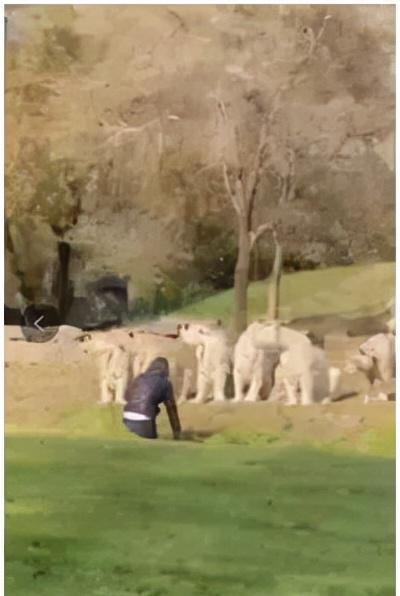Myth: Animals in safari parks have no protective measures at all, which is why accidents are frequent.
Truth: Safaris use covert segregation, but that doesn't mean it's absolutely safe.
A news item once said: "A tourist in beijing wildlife park got off the bus in the self-driving tour exhibition area, then climbed over the white tiger's isolation facility and confronted the white tiger at close range, and during the confrontation, he constantly shouted loudly and had very exaggerated movements to provoke the white tiger." Fortunately, the tigers who were watching did not plan to eat another meal, and the man was eventually taken away safely.

The man provoked the white tiger. | Source network
Although the man was lucky, there are many painful precedents for this dangerous practice in the country. In 2015, a female tourist got off the bus when visiting the White Tiger Park of Qinhuangdao Wildlife Park in Hebei Province, and died after being bitten, in 2017, a male tourist was attacked by a tiger in Ningbo Youngor Wildlife Park, and died after being rescued after being sent to the hospital, even if it is a city zoo, Beijing Zoo has a giant panda named "Gugu", in 2006-2012, it has been 5 times to bite tourists who have crossed the isolation facility and entered the activity area without authorization.......
In these zoo animal injuries, the main factor is the lack of safety awareness of tourists, ignoring the management regulations of the zoo, climbing over the isolation facilities and entering the animal cage or activity field, of course, the zoo also has the responsibility of mismanagement. But when many friends watch the video of the accident, they will ask: Why did the zoo not make isolation facilities for tigers?
The zoo's hidden isolation facilities
In fact, this is an advance in the design of the zoo on the animal cage. I remember when I was a child, in the 90s, the cages such as Monkey Mountain and Bear Mountain in Beijing Zoo were a "big pit", and people stood behind cement walls and looked down to see the animals, of course, there were uncivilized people throwing food to feed the animals, and animals such as beasts of prey and pheasants were mostly raised using metal cage nets.
Deer in a cage net. | Figureworm creative
Cage nets will affect the line of sight of tourists, so most of the current zoos use hidden isolation facilities, that is, isolation facilities that are easy to be ignored by tourists and do not block the line of sight. This can not only ensure the isolation of people and animals, but also do not affect the viewing of tourists, and can make people and animals a heads-up perspective, to avoid animals looking up at tourists to produce nervousness.
The most common way to use hidden isolation facilities in zoos is trenches, which can be divided into dry and water. As the name suggests, a water trench is a water injected into a trench that acts like a "moat" and is used by animals that generally do not like water, such as chimpanzees, gorillas and other primates.
The setting of the trench must be scientific, for example, the width of the trench should take into account the maximum jumping ability of the animal and the maximum vertical climbing ability. The V-shaped trench is generally a gentle slope with a small angle on the side of the sports field, which is conducive to avoiding injury and returning to the sports field when the animal accidentally enters the trench; the side of the tourist area is a steep slope with a large angle to avoid animal climbing.
Dry trenches are generally supplemented by other facilities such as tree segments, stones, fences, etc., such as ungulates are reluctant to move on sharper stones, and it is difficult to climb large rocks, so you can arrange a circle of stones on the edge of the trench that isolates ungulates.
In this accident, we saw that when the tourist confronted the white tiger, the white tiger did not advance, and there seemed to be some thin wire-like objects between the tourists and the white tiger, which is a kind of isolation equipment commonly used in zoos: electric grass.
Electric grass can be thought of as a special kind of power grid, with a stick in the middle, extending outward with many filamentous suction wires, looking like a shrub made of wire, or like an upside-down head massager. In general, the electric grass used in zoos is weakly electrified, and animals will not be harmed when they are shocked, but will only feel uncomfortable or awkward. Animals are more electrified when they cross the border, and they will form the consciousness of "here is the boundary". Around the elephant house sports field of the Beijing Zoo, it is easy to see the electric grass laid out. It is said that this equipment was originally used for livestock fencing.
The electric grass is like an upside-down head massager. | From the author
Because of its short height and slender branches, electric grass is not easy for tourists to find, and it is less harmful to animals, which is a very effective means of isolation. It is precisely because of the laying of electric grass that in this news, the white tiger did not pounce on the tourists. Although this tourist was lucky to escape from danger, the punishment of the law could not be escaped. According to later reports, the tourist has been criminally detained by the Beijing Daxing public security organs.
This article is produced by the "Scientific Rumor Dispelling Platform" (ID: Science_Facts), please indicate the source when reprinting.